Dance
Dance is a psycho-physiological expression of mood and emotion. Dance and language and inner emotion share a common thread. Temporally, dance in Bangladesh may be explained in four phases, such as 1. dance in ancient Bengal; 2. dance in medieval Bengal; 3. dance during colonial era; 4. dance in post colonial era.
The art of dancing has flourished in the orient in three ways, viz. Natya (drama), Nritta (monotonous dance), and Nritya (dance). Natya implies expressing one's thoughts through words and gestures. Nritya means dancing rhythmically without expressing any emotion. Nritya implies display of elegant artistic postures with beats and rhythms. The ancient art of dancing can be divided into three categories. These are: dance of small ethnic groups, scriptural or classical dance, and folk dance. The dance of small ethnic groups takes place on the occasion of festivals. The scriptural or classical dance has methodological grammar which has to be applied formally. On the other hand, the objective of folk dance is to entertain the audience. As against the classical dance, no procedural rigidity is observed in case of folk dance. In addition, modern and contemporary varieties of dances are observed in different countries of the world. These dances are primarily mixed creations; no specific grammar is followed in presenting them.
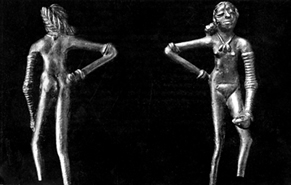
Harappa and Mohevjo-Daro were the principal sites of Indus civilization in the Indian subcontinent. Beautiful statues, clay dolls, Indian lute, bamboo-flute and tabor have been found in Harappa and Mohenjo-Daro civilization indicating existence modes at the time. The female dancing statues found at Mohenjo-Daro prove the ancient antecedence of the art of dancing in the subcontinent. Evidence of dancing has also been found in the Rig-Veda (oldest), Yajur-Veda, Sama-Veda and Atharva-Veda. The goddess Usha was compared with a dancer in the Rig-Veda. The king of gods, Indra was himself a dancer. Atharva-Veda mentions about vocal and instrumental music as well as dancing. The classical and folk categories of dances had their origin in the Sama-Veda.
During the age of the Puranas, the mythological fairies described in the ramayana of Valmiki were involved in dancing. It is conjectured that both Rama and Ravana were experts in dancing. But 'drama' and 'dance' were variously projected in the Ramayana. The mahabharata compiled by Vedabyasa mentions that Ghritachi, Menoka, Rambha, Shayamprova, Urvashi and Misrakeshi were fairies. The book also discussed about singers, dancers, drummers, hymns, deva-dunduvi, conch-bangle, lute, flute, tabor, rhythm and beat. Later, the Harivangsha Purana compiled by Jinsena Harivangsha (approximately 200 BC) spoke about Ras, Chhalikya and Asarita. The Ras was one of the main heritage of the Monipuri style of dance.
The Parasharya-shilalivyang Bhikkhunatasutrayo written by Panini in the fifth century BC and the Arthashastra written by Kautilya have mentioned the themes of physical acting, music and dance of the dancers. At that time, women used to stage dramas and dances. There were also arrangements for their state-sponsored training. According to the Kamasutra written by Vatsayana (approximately 200 BC), at least 8 forms of art out of a total of 64 were related to music and dance. These were: songs, dances, instrumental music, dramas, painting, dressing and make-ups, knowledge of rhythms, and knowledge of physical exertions.
During the classical era, the Natyashastra by Bharatmuni presented the grammatical form of dance and drama. On the other hand, Abhinoy-durpun (13th century) by Nandikexwar describes dance and drama in their pure forms. Evidences of ancient art of dance are also available in the book Mrichchha-katik written by Shudrak. It narrates the entry of an artist on the stage accompanied by the sounds of kansatal or metallic cymbals. The Nrityaratnavali by Joyasena and Sangeet Upanishat Swardhara by Bhajanacharya Sudhakala represent the heritage of Jaina music and dance literature. Abhinayachandrika of Maheswar Mahapatra of Orissa, Sangeet Damodar of Pundit Raghunath, Sangeet Narayan of Gajapati Narayan Dev, Srihasta Muktavali of Pundit Shubhankar (found in Assam), Nrityaratnakosh of Kumbhakarna of Rajsthan and Sangeet Mallika of Mohammad Shah of Central India provide various evidences of dancing.
The Dombis described in the charyapada were adept in dancing and singing. The Charyapada mentions about various musical instruments of ancient Bengal, such as ektara, heruk, vina, domru, damruli, banshi, madal, pat etc. The 17 charyas written by Vinapa (9th century) mentioned about the dance-display by Bajracharya as well as the drama Buddha.
In ancient times, dramas were primarily displayed in the form of dance. It can therefore be assumed that dance was an integral part in the drama Buddha or Tumburu. The folk traditions in acting, food, dances and dramas of that era has been depicted on the clay-plates discovered in Paharpur and Mainamati. The 10 stanzas composed by kahnapa speak of the expert Dombi dancer standing on 64 petals of a lotus, the documentary evidence of which is still preserved in Paharpur.
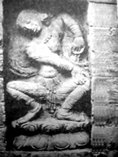
These terracotta pictures display female dancers wearing various ornaments in ear, neck, hand and feet. Two rooms were discovered at the site meant for presentation of dances. Among the composers of Charyapada were at least two Bhikkhu or Siddhacharya living at paharpur Buddha Vihara. There is no written document on the art of dance of the Babgalis. It is only during the time of the charyapadas (650-1200 AD) that evidences of dance, songs and dramas in ancient Bengal are available. The proofs of continuity of the history of dances, dance-skills, excellence of theme, mode of presentation in Bengal are found in various legends, deeds of gods and goddesses in narration and presentation of songs in the gatherings of the Dervishes. At that time, the Gorkh-dance emerged in Bengal on the basis of animist theories of the followers of Natha cult. The theme of this dance was play-acting by Guru and disciple. Gorkh dance applied a dancing technique in which the dancer used of display dance standing on the toes. This technique is observed in the display of dance in Bharatnatyam style. Drums and skirt-like dresses (ghagri) were used in Gorkh dance. Ghagri was basically a dress of the Rajasthani women. Ghagri is used in Kathak dance.
Details on Shiva-nritya (dance of Shiva) in Vanga is found in the book Gupichandrer Sannyas. In ancient time, Shiva and Gouri used to indulge in dancing by wearing masks of ghosts and demons. The frenzied dance of Shiva accompanied by the sounds of drums on the occasion of Chaitra Sankranti or sun-worship is still in vogue in the villages of Bengal. gambhira is considered as a component of the Shiva festival. The Gupichandrer Sannyas describes the rhythm, beats, drums, background acting and techniques of stage decoration in Vidyadhari dance of Bengal. Vidyadhari is an expert dancer in heaven. They used to perform dances on the stage by wearing expensive folded saris, holding golden case in left hand, golden broom in the right hand and garland on the neck. Their lips were coloured in red.
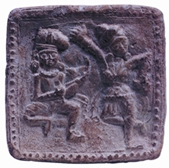
The book Sek-Shubhodaya by Halayud Mishra mentions about the ancient Bhadu song. Shunyapurana is the first book of poetry in the Panchali (musical dramatic poem) style. It mentions the practice of Shiva-nritya at Devasthan presented in the Panchali style. Songs accompanied by Shiva-nritya is an indigenous form of Nata-geet (musical drama) of ancient Bengal. Nata-geet is basically a dance-drama presented in a rhythmic style.
The Narad-nritya was in practice in twelve-century Bengal. The purpose of presenting humorous Narad-nritya was to entertain the audience. Narad undertakes a journey for meeting Jageshwara or Shiva riding on a husking pedal. His dance was Tethabga or Tribhanga (bent or crooked in three parts of the body) with the croaking of frogs in his voice (Tethanga hoia ja-a/bhekar sangeet ga-a). Similar to the Shunyapurana, we come to know about Harishcandra Nritya from the book Dharmamangala. The acting and dancing based on Geeta-Govinda by Joydeva were based on classical modes. Both Joydev and his wife Padmavati were adept in dancing and singing.
In the medieval period, the ritual-based Chhau-Nritya used to be presented by the devotees of Shiva. The artistes used to wear the masks of monkey, bear, cow, etc while presenting dances. In Chhau dances, Ganexa was one of the gods to be worshipped. The Chhau dances were performed based on legends like the dance of Durga, killing of the Mohisasur, combat of Kirat and Arjun, slaying of Bali etc. The style of its song belonged to the Jhumur category. Jhumur is the main tune of the festivals of small ethnic communities of this country, namely the santal, Oraon and Soirai, Baha and Jitia festival of the Mahalis. Just as some classical modes innovated by the Bangalis were incorporated in classical music, similarly scriptural dances were also created in the area of dancing; these have become extinct over time. Songs were applied parallel to dances; therefore, the existence of scriptural dances side by side with the scriptural modes of the Bangalis was not unrealistic. Consequently, Buddha or Noiramoni dance, Pakhuri dance, Vidyadhari dance, Gorkh dance, Ramayana dance, Shiva dance, etc were the indigenous scriptural forms of dances in Bengal.
The 13-volume of Xrikrishvakirtana written by Baru Chandidas was a massive work of narrative poetry composed during the 14th-15th centuries. Humorous and descriptive, the influence of Dhamali and Jhumur dances are visible in Srikrishnakirtana. Dances were introduced at many junctures while staging the Srikrishnakirtana as a musical play. One gets to know about Darbari dance while reading Ramayana written by Krittibasa Ojha (14th century) and Srikrishvavijay written by Maladhar Basu (1437-1480). They used to specifically apply classical music. There are descriptions of the presentation of tales as dance-dramas during the episode Ramayana Nat of Srikrishvavijay. In the drama Ramayana, there are descriptions on the themes of postures, speech, purity and eatables as well as a dance expert named Bhadranat.
There was an episode of dance by Behula in the court of paradise in Padmapurana or Manasamabgal of Vijaygupta. It was called Kanchasara dance. The female dance artiste displayed dance by moving from one earthen platter to another. These platters were very fragile and were burnt in fire after drying them in the sun. The dance artiste used to demonstrate her adeptness by minimising her weight during dance presentation. The ingredients of beautification for the dance of Behula were: chaki-korhi, makarkundala (ear-ring), besarphul (on nose), kanchuli (brassier), probalmala (conch necklace), kanak-kabgkan har (on hand), kejur (on arm), abguri (on finger), nupur (on feet), Gujrati ghubgoor (on feet), meghadambur Xari (dress), kusum urhani (Muslin orna). It can be inferred from the term Gujrati ghungoor that the Gujarati dance was once in vogue in Bengal.
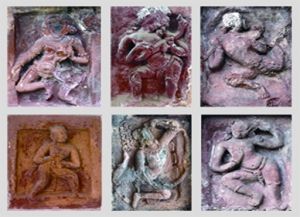
Various episodes of the Chandimangala by Mukundaram used to be staged as Astamangala. In all these episodes, the presentation signs were visible of pada, bolam katha, disha, nacharhi [and Puna nacharhi]. But in the Chandimangala by Manik Datta, mention was made of five classified parts, namely, varnana, nritya, disha, and ukti-pratyukti. Here, there were no references to panchali, bhabkali, boithaki, danra etc. According to Chaitanyabhagabata by Brindavan Das (1545 to 1553-55AD), varieties of dances were introduced in Bangla centring on Chaitanyadeva. Of these, the dances called Rukshiniharan Natya and Svanubhava Nritya were the outstanding ones.
The Dabkanritya used to be practiced during the 15th century for containing the fear of snake. The Danka artistes used to wear dresses showing pictures or alphabets of snake, or did mimicry of snake. The place for staging Danka dance was the household premises. Mridabga, mandira and string instruments (ektara, dotara) used to be applied during the dancing sessions. The Chaitanyamangala was composed by Jayananda during mid 16th century. Jayananda termed the kirtan based dances as sankirtan dance. In Sri Chaitanyamangala of Lochandas, there are descriptions of Ruxini Nritya or Gopika Nritya. Jal-Natya or Nritya were in practice during the time of Chaitanyadeva.
Mention of Barhai dance is found in the 16th century Govindamabgala of Dukhi Shyamdas. The subject of Betra Nritya has been discussed in the poetical work Dharmamangala (1711-12) by Mayurbhatta. The Chandimangala (1766) written by Ramananda mentions about Ratnamala dance. Ratnamala (fairy of paradise) used to engage in frenzied dances by blowing the conch-shell. The Vidyasundar dance of Bharatchandra mentioned in Annadamangala used to be presented as jatra or folk-drama. Another name of the Vidyadhari dance, which contained sexual overtures, was Tafa dance. Tafa meant fairy. Musical drama based on love-lore emerged at this juncture. Yusuf-Jolekha of Shah Muhammad Sagir was the first work of poetry belonging to this genre. Mention was made of musical dance during post-marital crisis of Jolekha and Aziz. The book of poetry Laily Majnu written by Daulat Wazir Bahram Khan mentioned about various dances and songs.
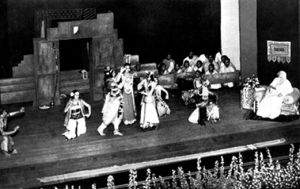
The topic of Nat has been covered in the book of poetry Chandravati by Koreshi Magan Thakur during the 17th century. Padmavati Kabya written by Alaol was an important work of poetry during this period. Descriptions of Dakshinatya dance and Chachri dance accompanied by different musical instruments was present in the Shastrer Sawal Jiggasha chapter of Padmavati.
The Manikpirer Panchali by Fakir Muhammad used to be staged in the form of a musical dance during the 18th century. Madarpirer Jari used to be presented as a musical dance in rajshahi region during maghi purnima. The main singer used to present dances by moving around. Saiful-Mulk Badiuzzamal of Poet Dona Gazi mentioned about the songs and dances of female dancers. Apart from their dancing engagements, the female dancers used to teach in the royal courts. The apsaras, devadasis, barabgana, baiji and nachni communities were the products of that period. In the book of poetry Modhumalati by Syed Hamza, dance and drama were staged before the prince Manohar. There were even arrangements for cash rewards for presentation of musical dramas and dances.
During the 19th century, Srikrishnakirtana was a popular musical drama in Dhaka alongside other regions of East Bengal. Rich adherents of Vaishvavism used to invite kirtanwalis. Sessions of Baiji dance used to take place in the compounds of the rich people. In those gatherings, the Kirtan songs were sung alongside Davka Kirtan and dances by the baijis. The devotees used to dance during the processions and gatherings organised on the occasion of Janmastami, the birthday of Sri Krishna, which was the main religious festival of the Hindus in Dhaka. Subadar Islam Khan introduced the Darbari dance for the first time in Dhaka. Regular sessions of songs and dances used to be held in his palace.

There were over one thousand dancers with the name kavchani in his parlour. Dhaka was also famous for its jatras (folk-dramas). Sitar Banabash was the first jatra-pala presented on the stage of Dhaka. Dance was an essential ingredient in these presentations. At that time, sessions of musical dances were held regularly at the recreation center of the French (later ahsAn maNzil) on the bank of the river Burigabga. The daily time-table of Nawab Abdul Ghani included enjoying dances and songs at noon (12 to 1 pm) and at night (11 pm to 1 am). A 16-day dance and song festival held at Ahsan Manzil sometime between 1875 and 1879. Regular sessions of Darbari dance used to be organised during the time of Nawab Abdul Ghani (1813-96) and Nawab Ahsanullah (1846-1901) of Dhaka. At that time, a female dancer spent 25,000 rupees for the annaprashana' (rice-giving) ceremony of her new-born baby. It was at a time when 1 maund of rice cost only 4 rupees. The patronisation of Darbari dance declined during the period of Nawab Salimullah. Devi Baiji presented dances in the function arranged on the occasion of marriage ceremony of Khwaja Kalimullah's son Khwaja Hamidullah on 20 February 1918. The practice of deva-dasi was abolished in the Indian subcontinent by a legislation in the Madras Assembly in early 20th century.
Devi Baiji of Zindabahar presented dances in the film The Last Kiss (1931) produced by the initiative of the Nawab family of Dhaka. Harimati Baiji also acted in this film. People belonging to both the Hindu and the Muslim communities altogether used to enjoy Baiji dance, Jhulan Jatra and the Janmastami processions. Jaddan Bai, mother of actress Nargis, Kajjan Bai, Akhtari Bai, Fayezabai, artiste Indubala and Harimati were the famous dancers of Dhaka during the time.
rabindranath tagore (1861-1941) introduced the dances of the Bangalis to the global community. He included dancing in the curriculum of Vixva-Bharati University in 1926 after enjoying Monipuri dance at Machhimpur of sylhet in 1919. Dances were presented for the first time in Varshamabgal programme of shantiniketan. Later, Rabindranath endowed Bangali dances with an artistic form by writing the dance-dramas Shyama, Chitrabgada, Chandalika, Mayar Khela, Natir Puja etc and by applying dances in them. In this endeavour, he tried to integrate and unify the Java-Bali dances, Kandi dance of Sri Lanka and different classical and regional dances of the Indian subcontinent. His dance-dramas are music based. He applied various dances in the dance-dramas by adapting songs with acting.
It was, however, Udayshankar (1900-1977) who revived many of the nearly lost modes of dances. He participated in dance presentations in various countries after joining the troupe of Russian Ballerina Anna Pavlova. He set in motion a new trend of art called 'Shabkarscope' by establishing the Indian Cultural Centre at Almora in 1940. His famous dances include Nirasha, Labour and Machinery, Great Renunciation, Melody, Goutam Buddha, Assam Ballet, Prakriti Ananda etc. He made the film Kalpana in 1948. He also taught at Rabindra-Bharati University for some time and discharged the responsibility of chancellor of the Paschimbabga Sangeet Academy.
bulbul chowdhury (1919-1954) presented the dances Kach O Devajani, Meghadut O Street Hunger as a co-artiste of Sadhana Basu (1914-1973) and in cooperation of Hemlata Mitra, the chairperson of Shishuder Mukta Bayu Seban Samity. He established Kolkata Cultural Centre and Oriental Fine Arts Association during 1935-36. He developed a new perspective in Indian dance. He created 82 dances within a span of only 35 years of artistic life. These included Kshudhita Pashan, Desh Premik, Dundavir Ahvan, Indrasabha, Bharat Chharo, and Shiva O Devjani.
Under the leadership of Gurusaday Datta (1882-1941) and Hemanga Biswas (1922-87), the Bratachari Society and Bratachari Lokanritya Samity took initiative for presenting the traditional Bangali dances called Jari, Jhumur, Sari, Kathi, Raybanshey, Dhali, etc. The Bengal folk dances took a structured shape by their initiative.
Gawhar Jamil (1927-80) and his friend Rabishankar Chatterjee established Shilpakala Bhaban at Rankin Street in Dhaka. Institutional practice of dancing was initiated through this institute. Its early students were Jayasree, Shipra Nath and Tapati. There was a dance teacher named Kesta Pal in the dancing arena of Dhaka during 1947-48. His pupils included Tolly Ray Palthi, Manju Khasnabish, Runu Bhowmik, Manju Bhowmik, Nargis Murshida and Selina Bahar. Gawhar Jamil directed the first dance-drama of this country titled Indrer Sabha in 1949. Its music director was Ostad Mir Kashem Khan (1928-84). Gawhar Jamil and his sister Shipra Nath played the central roles in this dance-drama. And it was in this year that the Shilpa Bhaban had to be shut down due to financial crisis.
bulbul chowdhury and his dance troupe came to Dhaka from Kolkata in 1949 for the purpose of collecting funds for the anti-tuberculosis campaign in East Bengal under the initiative of the then health minister habibullah bahar. His team members included Timir Baran, Shambhu Bhattacharya, Ajit Sanyal, Paritosh Sen, gaUhar jamil, Mir Kashem Khan, Mahmud Nurul Huda, Afroza Bulbul and her daughter Nargis. They presented dances titled Dunduvir Obhijan, Prokritir Ahvan, 'jiban O Mrityu, Iraner Ek Panthashala, Pachhey Bhuley Na Jai and Sapurey Nritya at Rupmahal cinema hall in Dhaka Sadarghat area.
In 1950, the daughters of some middle class families of Dhaka, such as Laila Samad, Rokeya Kabir, Kulsum Huda, Nayeema Huda, Begum Lily Khan, Zeenat (Chhoto Khuki), Meher (Barha Khuki) and Rosy Majid were enlisted as students of dancing. And at this juncture, Gawhar Jamil built up the cultural organisation named Kala-Bhaban. But the school had to be closed down within a short time. In 1951, another school named Surbitan was established by the initiative of Anwara Bahar Chowdhury (1918-87), former Headmistress of Kamrunnesa School. Gawhar Jamil served as a teacher at this institution. But its programmes had to be stopped when Anwara Bahar Chowdhury was transferred to Mymensingh Vidyamoyee Girls' School.
Bazlur Rahman Badal of Rajshahi did a choreography on Poet Nazrul's poem Bidrohi in 1954. Later, he directed the dance-dramas Radha-Krishva, Mohisasur Badh, and Satidaha. At that time, Radhapada Adhikari (1923-2000) of Dinajpur, Kunjalal Sarkar of Rangpur, Mihir Datta of Barisal, Baren Biswas of Jessore, Kameswar Singha of Sylhet, Anil Kishan Singha, Shankar, Haridas and Shefali made special contributions in the field of dance. The artiste Shefali of Sylhet presented Monipuri dance at a Sarod programme of Ostad Alauddin Khan held at Bardhwan House of Bangla Academy in 1955.
A dance-drama titled Ghumanta Rajkanya was displayed under the initiative of Bashanti Guhathakurta (1922-93), former Headmistress of Gandaria Girls' High School (Moniza Rahman Girls' High School) in 1955. It was directed by Ajit Sanyal. Rahija Khanam Jhunu played the role of shepherd in this dance-drama. Ajit Sanyal joined the Bulbul Lalitakala Academy (Bulbul Academy of Fine Arts or BAFA) in 1955.
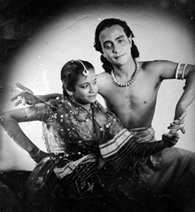
The Aryan Sangeet Samity was established in chittagong in 1906. The artistes of this association Dhiren Sen, Chunilal Sen, Runu Biswas and Anil Kumar Mitra played a unique role in the practice of dance. Chunilal Sen established the Sangeet Parishad (1939), Anil Mitra set up Prachya Chhanda Geetika and Runu Biswas founded Alauddin Lalitakala Academy (1967). The students of these institutions, who became established artistes later on, included Meena Pal Kabori, Lakshi Rakshit, Uma Ball, Sati Ball, Dolly Bhattacharya, Nimmi Rahman, Rahnuma Aftab, Meher Nigar, Kuntala Barua, Sheela Das and Sharmila Bandopadhyay.
The first full-length Bangla movie of East Bengal Mukh O Mukhosh, directed by abdul jabbar khan (1916-1993), was released at' Rupmahal cinema hall in Dhaka on 3 August 1956. Produced under the banner of Iqbal Films, its dance director and artiste was Gawhar Jamil (1927-80). In 1961, GA Mannan (1931-92) directed the dance-drama Nakshi Kanthar Math written by Jasimuddin. It was converted into a dance-drama by AKM Mujtaba while its music was directed by Ostad Khadem Hossain Khan. GA Mannan launched the Nikkon Lalitakala Academy in 1963. His famous dance-dramas include Naksi Kanthar Math, Mohua, Kashmiri, Adhik Khadya Phalao etc.
The Jago Art Centre was established under the joint venture of Gawhar Jamil and Rawshan Jamil (1931-2002) in 1959. The Chhayanaut Sangeet Vidyayatan was set up in 1961 under the sponsorship of Poet Sufia Kamal (1911-99), Farida Hasan, Wahidul Haque, Sanjida Khatun and Kamal Lohani. The dance-drama Chandalika of Rabindranath Tagore was staged by chhayanaut at the curzon hall on 28 April 1963 on the occasion of the birth centenary of the poet. Mandira Nandi played the role of Prokriti and Selina Bahar played the role of mother in the dance-drama. Aminul Islam Tula played the character of Ananda. Planned by Ajit Sanyal, this dance-drama was directed by Bhaktimoy Dasgupta. The dance department of Chhayanaut was started under the supervision of its teacher Laila Hasan. Zeenat Jahan (1940-2002) joined as a dance teacher of Sangeet Mahavidyalaya which was established by Barin Majumdar in 1964. She was a graduate in the art of dancing from Brajendrakishore Sangeet Mahavidyalaya of Kolkata. The dance-dramas directed by her included Esho Basanta Phirey Jeona, Dur Dwipbashini, Shyama and Mayar Khela.
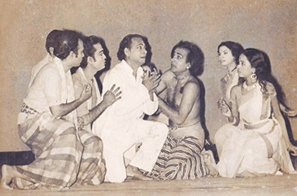
Jogeshchandra Das (1926-2006) of Mymensingh learnt dancing from Anita Dasgupta, a teacher of Visvabharati University, in 1965. He established Nataraj Shilpi Niketan in 1965 and directed the dance-dramas Mohua, Jamunabatir Duhkha, Ali Baba Challish Chor, Rakhal Bandhu and Agnibeena. Shyama of Rabindranath was staged in 1965, which was produced by the music institute Boitalik and directed by Laila Hasan. The dance-dramas directed by her included Chitrabgada, Shapmochan, Amar Varnamala, Nari Mohiashi.
The dance teacher of Mymensingh Mukul Fouj, Yunus Ahmed Bablu (1943-2001), directed the dance dramas Mon Pabaner Nao, Mohua, Molua and Agnibeena in 1966. Later, artiste Amanul Haque directed the dance-dramas Battle of Bangladesh, Zulfiqar, Mon Besatir Hat and Jolchhey Agun Kshetey Khamarey.
In 1967, a dance teacher of Lucknow Morris College Monzur Hossain taught the Kathak form of dance in Dhaka for some days. His disciple Syed Abul Kalam worked for spreading Kathak dance in this country. In Khulna, Rashed Uddin Talukdar (1942-2004) directed the dance-dramas Bidrohi Beer, Golaper Samadhi etc. He established the Nazrul Academy in Khulna in 1969.
Altamas Ahmed (1937-98) and his wife Shaheda Altamas (1946-86) established the dance school Sangeet Bitan in 1969. Dance-dramas directed by them included Shatabdir Swapna and Beerangana Sakhina. Artiste Abul Kasem (1940-91) set up Jhankar Lalitakala Academy in 1967. The dance-dramas directed by him were Sojan Badiyar Ghat, Gunai Bibi and Beder Meyey. The dance-drama Rajpath Janapath written by Enamul Haque was adapted by Babu Ram Singha, Habibullah Chowdhury and Kajal Mahmud and produced by Bulbul Academy of Fine Arts (BAFA). Its music was directed by Shaheed Altaf Mahmud (1933-71).
Pijush Kiran Pal and Nikunja Bihari Pal used to teach at Kishoreganj Art Council. Their names remain luminous in the arena of music and dance. Among the accomplished dancers of the 1970s, the names of Ajit Kumar Dey, Dalia Nilufar, Dalia Salauddin, Golam Mostafa Khan, Manzur Chowdhury (1945-92), Humayun Kabir, Mayeedul Islam, Sharmin Hossain, Zeenat Barkatullah and Hasan Imam are notable.
During the post-liberation period, dance-artiste Alpana Mumtaz (1948-2004) established the Kathakali Sangeet Academy. Kathakali staged the dance-drama Chandalika in 1972 by keeping provision for entry tickets. Later, Boitalik and Benuka Lalitakala Kendra, sub-continental musical groups Sadhana and Dhrupad Kala Kendra played a leading role in commercial presentation of dances with provision for entry-tickets. But this trend could not be sustained for long.
Planned by Mustafa Monwar, the programme 'Natun Kuri' was launched on Bangladesh Television in 1977. Its objective was to raise the creative skills of children. Dancers Tarana Halim, Rumana Rashid Ishita and Tarin were its products. bangladesh shilpakala academy was set up in 1974. The training department of the Academy organised workshops on dancing at its 62 district branches. Established in 1977, bangladesh shishu academy is imparting training to children in 60 districts of the country on music, dance and fine arts.
Bangladesh Nrityashilpi Sangstha was set up in 1978 under the aegis of Gawhar Jamil, G A Mannan and Altamas Ahmed. Since its inception, this organisation is arranging various events including dance programmes, seminars and award of honours. In 1980, Wahidul Haque (1933-2007) brought Shantibala Sinha to Dhaka from Sylhet in order to teach Monipuri dance at Chhayanaut. The same year, Golam Mostafa Khan established Benuka Lalitakala Kendra. Outsanding among the dance-dramas he directed were Benukar Sur, Tin Surey Gantha and Raktalal Ahankar. Bangladesh Television started broadcasting the children's dance programme 'Rumjhum' in 1980. Laila Hasan was the principal planner and trainer of the programme. Later, Bangladesh Television aired the programmes 'Chhandey Anandey' and 'Nrityer Taley Taley'. These programmes played an important role in popularising the practice of dancing throughout the country.
Among the dance artistes of the 1980s, Begum Siraj Serniabat, Ilyas Haider, Nazma Gafur, Rawshan Ara Begum, Khwaja Hossain Ahmed Lotan, Manoshi Das Talukdar, Meenu Haque, Amir Hossain Babu (1953-2004), Peenu Khan, Lubna Mariam, Selina Begum Shelley, Saleha Chowdhury, Reshma Firoz, Kamal Sarkar (1957-93), Dolly Iqbal, Anjana Ray Jaba, Nilufar Begum, Nilufar Wahid Papri, Anita Sinha and Namita Kundu were the outstanding ones.
The National Performing Arts Academy organised a 6-month long training programme in 1981 on various dances created by the dance-guru Bulbul Chowdhury. Afroza Bulbul was its instructor. Shukla Sarkar and Belayet Hossain Khan have been playing a unique role since 1985 in the flourishing of classical dance in the country. The Indian dance-artistes Sangjukta Panigrahi and Sani Mohapatra conducted two workshops on Orissa dance in Dhaka in 1985 and 1989 respectively. Their worthy successors Meenu Haque and Tamanna Rahman have continued their practice of Orissa dance. Important dance-artistes of the 1990s include Sultana Haider, Abdus Samad Palash, Deepa Khandakar, Shamim Ara Nipa, Musa Khan, Shafiqur Rahman, Rafiqul Islam Shafiq, Meena Nazrul Islam, Amirul Islam Moni, Md. Shariful Islam, Sohel Rahman, Kabirul Islam Ratan, Sarwar Ahmed, Abdur Rashid Swapan, Fatema Kashem, Iqbal Ahmed, M R Wasek, Azizul Islam, Swapan Das etc.
Among the classical dances practiced in Bangladesh, Bharat-Natyam, Monipuri, Kathak, Orissi and Kathakoli are the most popular. Soma Mumtaz, Anisul Islam Hiru, Shubhra Sengupta and Baby Rozario have received training on Bharat-Natyam from different institutions of India. Similarly, Shibly Mohammad, Saju Ahmed, Munmun Ahmed, Tabassum Ahmed, Aruna Haider, Kochi Rahman, Kazi Raquibul Haque have received training on Kathak dance; Benazir Salam received training on Orissi dance while Lubna Chowdhury received training on Kathakoli dance. They have already played a notable role in systematic practice of dancing in Bangladesh. In recent times, Parvin Sultana, Sandwip Ray, Sadia Islam Mou, Farhana Chowdhury Baby, Nazmul Haque Lenin, Abdus Sattar, Kasturi Mukherjee, Likhan Ray, Mostaq Selim, Gopal Kundu, Sanjib Chakrabarty, Abul Hasan Tapan, Enamul Haque, Salma Munni, Samina Hossain Prema, Warda Rihab, Evan Shahriar, Shahidul Islam, Anik Basu, Nilanjan Das Juin, Ananya Barua, Ladli Mohan Mitra have played bright roles in the staging of dance-shows.
The International Theatre Institute (ITI) declared 29 April as International Dance Day in 1982 in memory of the noted dance exponent Jean-Georges Noverre (b. 29 April 1727, Paris). The Bangladesh centre of International Theatre Institute and Bangaldesh Nrityashilpi Sangstha have been observing this day jointly since 1992 through processions, seminars, dance-fair, dance-exhibition, photographic exhibition, etc.
The dance organisations Nrityadhara, Nrityavchal, Srishty Culture Centre, and Benuka Lalitakala Kendra have organised a number of dance festivals during the first decade of the 21st century. Besides, 4 countrywide dance festivals and Bulbul Chowdhury dance festival were organised under the auspices of Bangladesh Nrityashilpi Sangstha. Over one thousand dance artistes of the country, both from the classical and folk traditions, including those from small ethnic groups, participated in the festivals. The organisation has taken steps for inclusion of dancing in the curriculum of primary and secondary education as well as opening of a separate department on the art of dancing at university level.
Around 25 thousand pupils are involved with the practice of dance in over 225 dance schools all over the country. On the other hand, cultural troupes are being sent from Bangladesh to different countries of the world under cultural exchange agreements with 39 countries. As a result, the skills of dance-artistes are increasing fast. [Sheikh Mehedi Hasan]
Bibliography Sukumar Sen, Bangala Sahityer Itihash, Kolkata, 1991; NR Ray, Bangalir Itihash Adiparba, Kolkata, Agrahayan, 1382; Sureshchandra Bandopadhyay, Tin Hajar Bachharer Lokayata Jiban, Kolkata, 1383; Ahmad Sharif, Bangalee O Bangla Sahitya, Dhaka, 2000; Atindra Majumdar, Charyapada, Kolkata, 1388; Selim Al Deen, Modhya Juger Bangla Natya, Bangla Academy, Dhaka, 1996; SJ Ahmed, Achinpakhi Infinity: Indigenous Theatre of Bangladesh, University Press Limited, Dhaka, 2000.
